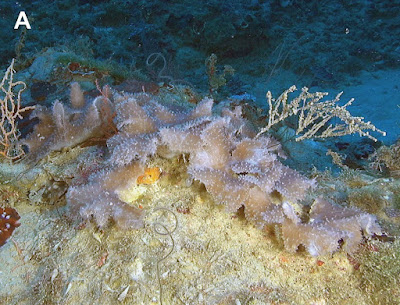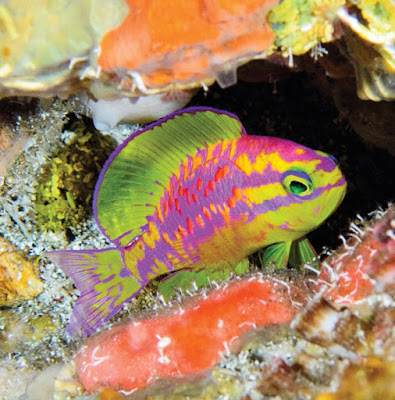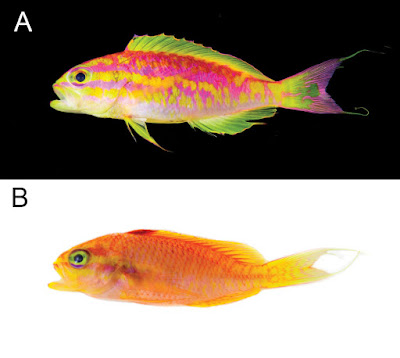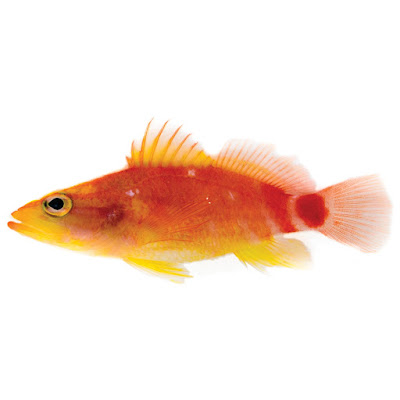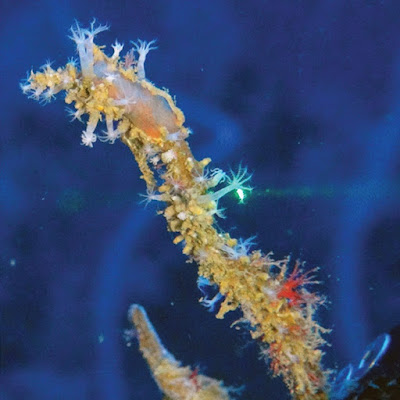 |
| Altumia delicata Benayahu, McFadden & Shoham, 2017 |
Abstract
This communication describes a new octocoral, Altumia delicata gen. n. & sp. n. (Octocorallia: Clavulariidae), from mesophotic reefs of Eilat (northern Gulf of Aqaba, Red Sea). This species lives on dead antipatharian colonies and on artificial substrates. It has been recorded from deeper than 60 m down to 140 m and is thus considered to be a lower mesophotic octocoral. It has no sclerites and features no symbiotic zooxanthellae. The new genus is compared to other known sclerite-free octocorals. Molecular phylogenetic analyses place it in a clade with members of families Clavulariidae and Acanthoaxiidae, and for now we assign it to the former, based on colony morphology. The polyphyletic family Clavulariidae is, however, in need of a thorough revision once the morphological distinctions among its phylogenetically distinct clades are better understood.
Keywords: Octocorallia, new genus, taxonomy, mesophotic coral ecosystem, Eilat, Red Sea
Family Clavulariidae Hickson, 1894
Subfamily Clavulariinae Roxas, 1933
Altumia gen. n.
Diagnosis: Clavulariinae with a thin and soft encrusting base, sometimes resembling a short stolon. Polyps erect when expanded, separate from each other; the stolon may feature a few polyps, occasionally only one. Polyps fully retractile into base of the colony, forming low truncated dome-shaped mounds. No sclerites in any part of the colony. Colonies lack symbiotic algae (zooxanthellae). Type species: Altumia delicata sp. n. by original designation and monotypy.
Etymology: The generic name is derived from the Latin ‘altum’, deep, referring to the habitat of the new genus at MCE depths and beyond. Gender female.
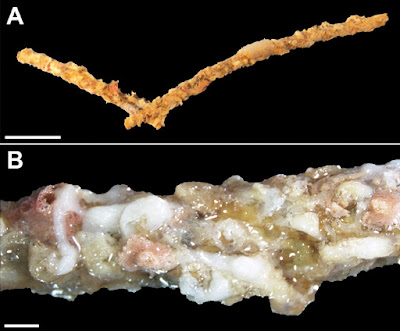 |
| Figure 2: Altumia delicata gen. n. sp. n. holotype ZMTAU CO 37427. A Colony growing over a branch of a black coral B close up of holotype. Scale 10 mm at A, 1 mm at B. |
Altumia delicata sp. n.
Holotype: ZMTAU CO 37427, Israel, Gulf of Aqaba, Eilat, 29°30'38.31"N, 34°55'59.30"E, 132 m, 30 May 2016, collected by ROV, coll. M. Weis; paratype: ZMTAU CO 37495, Israel, Gulf of Aqaba, Eilat, 29°30'37.29"N, 34°55'59.28"E, 118 m, 8 March 2017, collected by ROV, coll. M. Weis
Diagnosis: The ethanol-preserved holotype is comprised of thin patches of short stolon-like crusts growing over the dead branch of a black coral (Antipatharia) (Figure 2A), almost invisible to the naked eye. The milky-white, thin (<0.5 mm) crusts are a few mm long (Figure 2B), very soft, almost slime-like. Polyps completely retracted and practically invisible in the preserved colonies. No sclerites observed in any part of the colony.
Intraspecific variability: There are no differences between the holotype and the paratype except for the size of the colonies.
Etymology: The species name is formed from the Latin ‘delicata’, delicate, referring to the fine texture of the colonies and their polyps. Gender female.
 |
| Figure 3: Altumia delicata gen. n. sp. n. live colonies. A, B colonies growing over branch of black coral with expanded polyps C colonies growing on PVC net (arrow heads). |
Yehuda Benayahu, Catherine S. McFadden and Erez Shoham. 2017. Search for Mesophotic Octocorals (Cnidaria, Anthozoa) and Their Phylogeny: I. A New Sclerite-Free Genus from Eilat, northern Red Sea. ZooKeys. 680: 1-11. DOI: 10.3897/zookeys.680.12727
---------------------------------------------------------------
روابط التحميل والمشاهدة، الروابط المباشرة للتحميل
او
شاهد هذا الفيديو القصير لطريقة التحميل البسيطة
كيف تحصل على مدونة جاهزة بآلاف المواضيع والمشاركات من هنا
شاهد قناة منتدى مدونات بلوجر جاهزة بألاف المواضيع والمشاركات على اليوتيوب لمزيد من الشرح من هنا
رابط مدونة منتدى مدونات بلوجر جاهزة بآلاف المواضيع والمشاركات في أي وقت حــــتى لو تم حذفها من هنا
شاهد صفحة منتدى مدونات بلوجر جاهزة بألاف المواضيع والمشاركات على الفيس بوك لمزيد من الشرح من هنا
شاهد صفحة منتدى مدونات بلوجر جاهزة بألاف المواضيع والمشاركات على الفيس بوك لمزيد من الشرح من هنا
تعرف على ترتيب مواضيع منتدى مدونات بلوجر جاهزة بآلاف المواضيع والمشاركات (حتى لا تختلط عليك الامور) من هنا
ملاحظة هامة: كل عمليات تنزيل، رفع، وتعديل المواضيع الجاهزة تتم بطريقة آلية، ونعتذر عن اي موضوع مخالف او مخل بالحياء مرفوع بالمدونات الجاهزة بآلاف المواضيع والمشاركات، ولكم ان تقوموا بحذف هذه المواضيع والمشاركات والطريقة بسيطة وسهلة. ــــــــــــــــــــــــــــــــــــــــــــــــــــــــــــــــــــــــــــــسلامـ.







